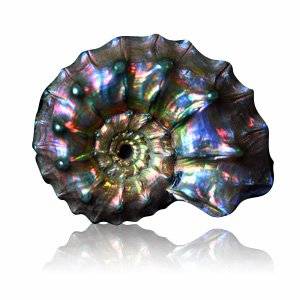Opal Fossils

Lightning Ridge - Black Opal Fossils
Lightning Ridge, located in northern New South Wales, is said to be the only place in the world where black opal fossils have been discovered. The region is rife with land-based organism fossils such as pinecones, platypuses and even huge dinosaurs. Fossils that have been found are remnants of plant, shell or bone material and are often made up of quality black opal that is said to be as valuable as a diamond.
Black opal fossils mined at Lightning Ridge also incorporate the remains of ; mussels, plants snails, crustaceans, plesiosaurs, fish, crocodiles, turtles and a host of other animals that walked the Earth millions of years ago. Deposits in Lightning Ridge now yield some of the most beautiful, rare fossils on the planet.
The fossils at Lightning Ridge are three dimensional organic objects that become trapped into both colourless potch, as well as precious opal. Most of the fossils at the Ridge are combinations of pseudomorph and replacement specimens. While the silica in the sediment has destroyed much of the bio molecular evidence, capillaries, marrow tissue, nerve channels and blood vessels, all remain perfectly preserved. When the potch is colourless, it is easily possible to see these fossils underneath the surface of these opalized remains.
The reason why these fossils are so well-preserved is because opal-dirt is very fine and therefore a perfect casting medium. Opal clay is made up of; Smectite, Kaolinite and Illite that give it its putty-like, malleable nature.
While most of these fossils are preserved in potch, it is not uncommon to find those with precious opal. Unfortunately, the heavy machinery used in excavation can often damage these fossils. This is why operations using picks and shovels are preferred in this area. Moreover, many of these fossils go unrecognized by miners only searching for colour.
South Australian Fossils
The Eromanga Sea covered the entire interior of the country approximately 100 to 120 million years ago. The shallow part of the sea was rich in aquatic life such as Ichthyusaurs, plesiosaurs, fish, ammonites, sharks and belemnites. Slow moving creatures like starfish, cockles, mussels and snails were found on the seabed. It is only the creatures that lay on the seabed that came into contact with the sediment required for fossilization. Some were infused with clear silica, while others were replaced by precious opal.
One of the areas that explorers have encountered much success in finding fossils is that of Moon Plain, situated approximately 35 km from Coober Pedy, South Australia. Moon Plain was a region that was once covered by sea, and filled with aquatic life. It is widely regarded as one of the most popular spot for palaeontologists.


